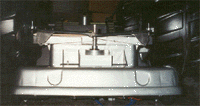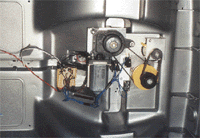
The Power Wheels car was designed for a child to sit in it and
provide manual
steering. To allow for remote control instead of manual
control, we have constructed a servo-controlled  cam that converts
the
rotational
motion into translational or linear motion. A servo is an
electromechanical device which uses feedback to provide precise starts
and stops for such functions as motors.
cam that converts
the
rotational
motion into translational or linear motion. A servo is an
electromechanical device which uses feedback to provide precise starts
and stops for such functions as motors.
 The
front wheels will be the ones to steer the rover left and right while the
back wheels move the rover forward and backwards. Power steering has been
implemented on the rover. There are two input pins: one to control the
direction (left and right) and the other to turn the rover on and off. A
potentiometer (a variable resister) allows
feedback of the
position
of the wheels to be sent back. Limit switches will prevent the wheels
from turning too far.
The
front wheels will be the ones to steer the rover left and right while the
back wheels move the rover forward and backwards. Power steering has been
implemented on the rover. There are two input pins: one to control the
direction (left and right) and the other to turn the rover on and off. A
potentiometer (a variable resister) allows
feedback of the
position
of the wheels to be sent back. Limit switches will prevent the wheels
from turning too far.
Back Wheels and Controls
The original Power Wheels motors will drive the back wheels
to go forward and backwards and draws a maximum
of 12 (during acceleration) and an average of 9
amps.



